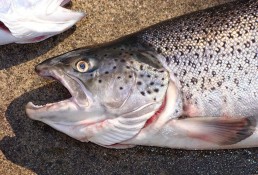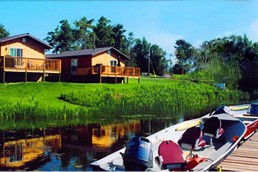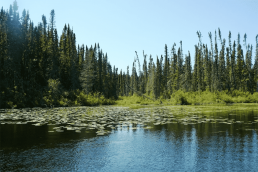The Promise of a River and a Promise to a Wife
Twenty-six years ago I assured my girlfriend that I would take her fishing for brown trout along the banks of the Bear River in Petoskey. It wasn’t until five years ago—on our 25th wedding anniversary—that I was able to fulfill that promise. Though we landed only a couple of small browns, we came away awed by what had been done to this river and its banks over the years to ensure that all outdoor enthusiasts might be able to enjoy this stretch of water.
For the most part, the Bear River is a slow-moving river, yet the largest tributary of Little Traverse Bay in the northwest corner of the Lower Peninsula. The river is formed as the outflow of Walloon Lake on the boundary between Charlevoix County and Emmet County, draining from the southeast end of the lake near the community of Walloon Lake. The river flows east for about 2 miles before turning north through Bear Creek Township, angling northwest to empty into Little Traverse Bay—its approximate length is 12 miles.
With its natural beauty, lazy bends for novice canoeists, and ample trout existing in a myriad of deep holes, the Bear has received plenty of attention from avid outdoor adventurers. However, most of its more recent notoriety has evolved with the spring and fall runs of steelhead. Dozens of hopeful shore and boat anglers can be seen lining the shore and breakwall areas near “the mouth” in hopes of landing one of these steel ghosts.
However, when the final step to securing bonds for a facelift was achieved in April of 2010, life for the Bear became even more pronounced. In the spring of 2011, local residents and visitors alike were treated to a vast array of positive changes.
From viewing platforms to pedestrian bridges to 1.6 miles of trails (paved, non-motorized and handicapped accessible on one side, natural paths on the other) the Bear River, which bisects the city of Petoskey, has undergone a $2.04 million restoration. Granted, many of the changes have made this area user-friendly for walkers, joggers, and whitewater enthusiasts, but there also has been a transformation in the river itself.
For instance, viable rapids start at the Sheridan Street Bridge with an 80-foot drop in elevation. For kayakers this could be fun; for anglers, the myriad of eddies and pools as a result of the elevation drop offers trout holes galore. With more than 800 brown trout released in the pre-spring weeks of 2011, casters can surely find ample opportunities to be successful with fly or spincast equipment.
Riffles, step-down water falls, and undulating currents are significant, especially a short trek up from the Lake Street river mouth. Within this section alone there are numerous boulders and a rocky bottom, which only helps fuel the habitat for browns and steelhead.
The project was paid for through a tax-increment funding via revenues dedicated to a certain district (the waterfront within a municipality). This revamping was 30 years in the making with original plans for improvement starting in the late 1970s. It took 26 years to fulfill a promise; it took three decades to put a facelift to one of Michigan’s most serene rivers.
Indeed, my wife had plenty of patience and the Bear quietly waited until I could see just how wonderful both of them are.
MWO
SHARE THIS POST
You may also like...
Did you enjoy this post?
You can be among the first to get the latest info on where to go, what to use and how to use it!
MWO
We believe being outdoors is good. With more than 1,000 articles each year, MidWest Outdoors magazine is all about sharing outdoor experiences with you—where to go, what to use and how to use it… whether you’re close to home or on that trip of a lifetime.



